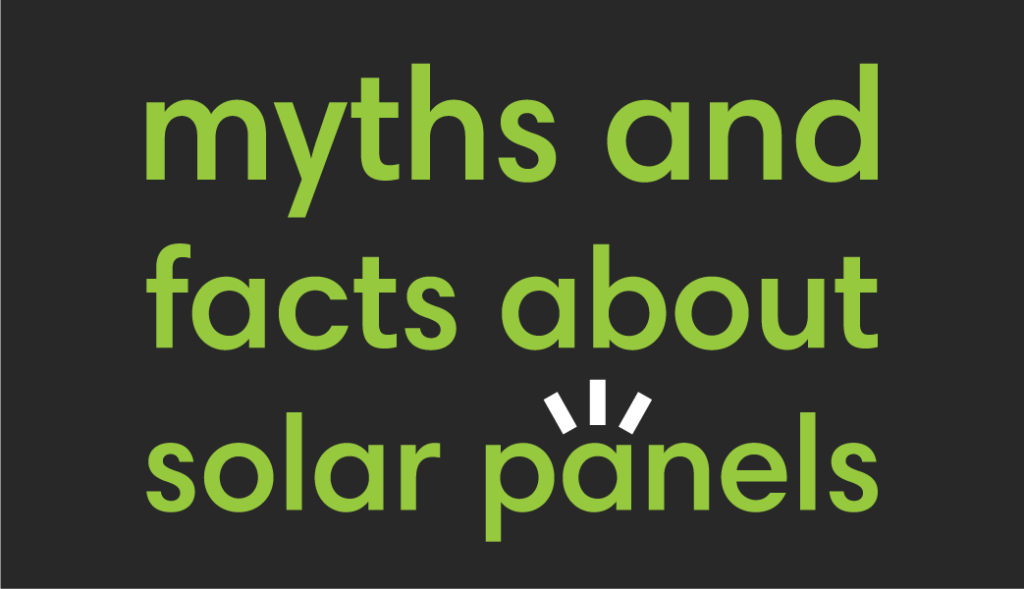Solar Panels Facts and Myths
 There are a lot of solar panels facts and myths and in general around photovoltaic solar energy. In this blog we will share with you some of the most common facts and myths that we have experienced from consumers questions.
There are a lot of solar panels facts and myths and in general around photovoltaic solar energy. In this blog we will share with you some of the most common facts and myths that we have experienced from consumers questions.
1.Fact: With solar panels I can produce all the energy I need and not pay a monthly bill to the network provider.
This is a fact when a system is off-grid since it uses energy storage batteries, allowing the consumer to generate 100% of the energy they need. When a system is on-grid, 100% of the energy generated can be consumed. However, this will depend on diverse factors such as the available space, the dynamics of consumption (the way and time in which the energy is consumed) among others. Correct training and in-depth knowledge of national regulations will allow a design to maximize energy coverage, savings and performance. Hence the importance of using selection criteria that go beyond price to choose the company that supplies, installs, operates and maintains the solar project.
2. Myth: Having an off-grid system is a risk.
This is a myth, as long as you have high quality equipments and a system installed and designed by certified professionals. You can depend 100% on an off-grid system, if the above is a reality. A fault in the installation might cause an undefined power outage. Therefore the importance of an impeccable installation.
3. Myth: Having an off-grid system is illegal in Costa Rica.
This is a myth since having an off-grid system is a private energy solution. We can compare it to the fact of deciding whether using the public water network or a private water well. The only condition is to completely isolate form the public network and become “an island”.
4. Myth: In a cloudy day, the solar panels do not generate electric power.
This is a myth. As long as there is sunlight (radiation), the solar panels produce energy. Nevertheless, this production will be less during rainy and cloudy days. When designing a photovoltaic solution, the specialists consider the historical climatology of the sites to predict the months, days and moments of less radiation and this way consider the decrease in the production of energy, so that the desired result is achieved.
5. Myth: The cost of a photovoltaic system is too expensive.
This is a myth since the cost of the system will depend on the consumer’s energy demand, available space for installation (access, location, infrastructure) and mainly on the objective. Some projects focus on savings, others seek for CO2 compensation and environmental imagen, and other a mix of both. These factors can determine the size of the systems and therefore their costs.
6. Fact: If I live at an apartment building, I can install solar panels to give energy only to my apartment.
This is a fact if the apartment has an independent energy meter and available space on the roof. If you share the same roof with other apartments, a permit from the other landlords will be needed to make the installation.
7. Fact: The savings percentage in the electric bills differs between sites.
This is a fact. Several factors will determine the percentage of savings of a system. It is not possible to standardize a savings percentage.
8. Fact: Through photovoltaic systems, I can reduce CO2 emissions.
This is a fact; photovoltaic solar energy is a type of clean energy. This means that to produce energy through this technology, there is no negative environmental impact, if you compare it to a fossil fuel power plant generator. Some consider hydroelectric energy as a clean energy, however, building these types of production plants can be very harmful for the environment (ecosystem affections).
9. Myth: It is impossible to calculate the avoided CO2 emissions through a photovoltaic system.
This is a myth. The Energy and Environment Ministry of Costa Rica and the National Meteorological Institute, share data regarding CO2 emissions for each industry. Also, the inverters monitor the performance of faults and other factors of the system to calculate the avoided emissions compared to a fossil fuel energy source or to a negative environmental footprint.
10. Myth: If I have solar panels, I can increase the energy consumption and get the same savings.
This is a myth since the design of a photovoltaic system is done based on the energy consumption history. Assuming that the demand of energy will behave similar to the consumption history, the system installed is one that can supply that demand. So, two things can happen if a consumer thinks that he/she can spend more energy. First, the demand increases, therefore, the projection of the savings will not be fulfilled. And second, there is energy waste, meaning a low economic and environmental consciousness.
11. Fact or myth: If I have solar panels, I no longer have to pay an electricity bill.
This is a fact if your system is off-grid. However, it is a myth if your system is on-grid. In this case, you will get an electric bill but this might come with a preference rate.
